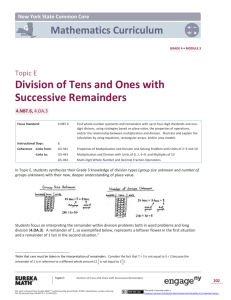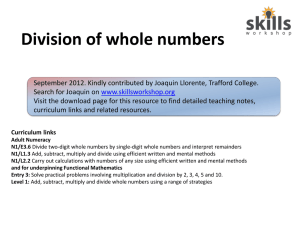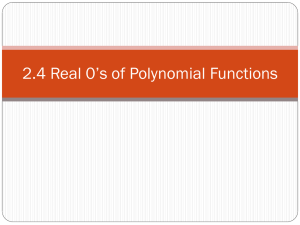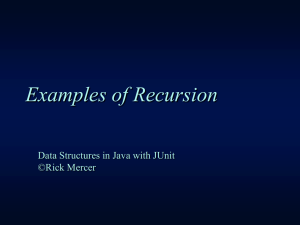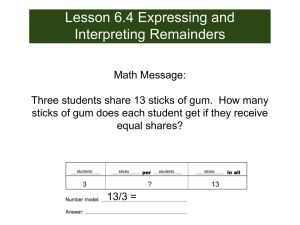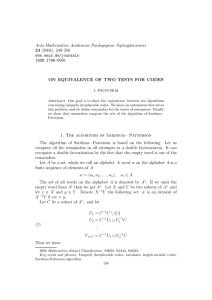Section 3.7: Modular Arithmetic and Ciphers
advertisement
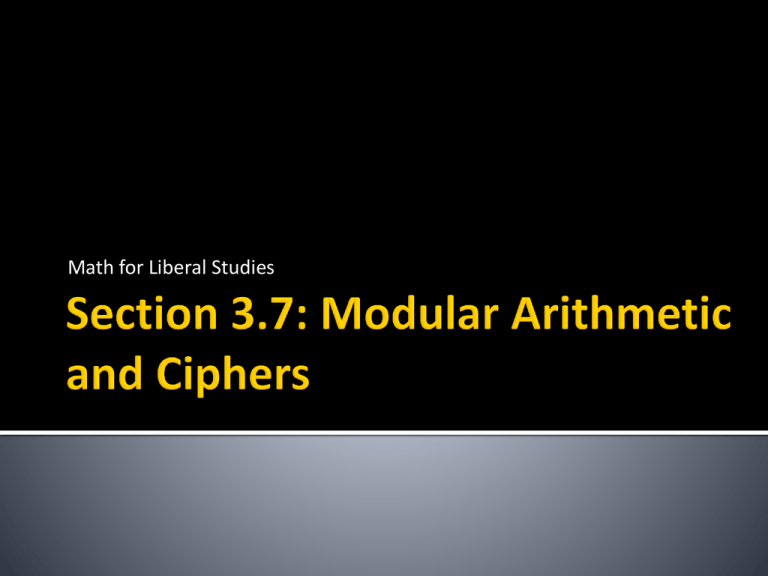
Math for Liberal Studies When we studied ID numbers, we found that many of these systems use remainders to compute the check digits Remainders have many applications beyond check digit systems Suppose today is Monday, and you want to know what day of the week it will be 72 days from now Since there are 7 days in a week, every 7 days we will return to Monday If we divide 72 by 7, we get a remainder of 2, so in 72 days it will be Wednesday Suppose it is currently April; what month was it 27 months ago? There are 12 months in a year, so every 12 months, we return to April When we divide 27 by 12, we get a remainder of 3. So we count 3 months back from April and get January We want to create a new arithmetic based on remainders We always have to keep in mind the number that we’re dividing by to get the remainders This number is called the modulus If we are talking about a “days of the week problem,” the modulus is 7 The possible remainders we can get are 0, 1, 2, 3, 4, 5, and 6 Each of these remainders represents a different day of the week We can number the days of the week 0 through 6 The question “Today is Thursday, what day is it 5 days from now?” can be represented by the equation “4 + 5 = ?” Now in regular arithmetic, 4 + 5 = 9 Since 9 isn’t a valid remainder, we divide by 7 and get a remainder of 2; so the answer to the original question is Tuesday Today is Thursday… what day is it 1000 days from today? 4 + 1000 = 1004… divide by 7, we get a remainder of 3, so the answer is Wednesday If we’re working with months of the year instead of days of the week, the modulus is 12 We can number the months with our possible remainders, 0 through 11 We could start with 0 for January, 1 for February, etc., but this wouldn’t match up with our standard numbering Instead we’ll start with 1 for January, 2 for February, etc., up to 11 for November We can’t use 12 for December because 12 isn’t a valid remainder We’ll use 0 for December Now consider this question: If it is currently March, what month was it 8 months ago? We can represent this question with the equation “3 – 8 = ?” In normal arithmetic, the answer would be -5 But -5 isn’t a valid remainder We could try to divide -5 by 12 and determine the remainder, but this is tricky with negative numbers Instead, remember that we can always add or subtract 12 from any number, and that won’t change the remainder when the number is divided by 12 So we take -5 and add 12, getting 7 This tells us that the answer to the original question is July Our equation looks like “3 – 8 = 7” This modular arithmetic works with any modulus greater than 1 We are going to apply these ideas to cryptography, so we’ll be using a modulus of 26 Each letter of the alphabet will be represented by a number from 0 to 25 0A 1B 2C 3D etc. 25 Z Recall that the Caesar cipher adds 3 to each letter of a message We can think of this as “adding D” to each letter Our encoding process now looks like this: To compute C + D, for example, we convert C and D to numbers and get 2 + 3 = 5, then convert 5 back into a letter (F) Our encoding process now looks like this: To compute Y + D, we get 24 + 3 = 27, but 27 is too big, so we find the remainder, which is 1, so Y + D = B Since adding D to every letter is our encoding process, the decoding process should be to subtract D from every letter Again we replace the letters with the corresponding numbers, and perform the calculation in modular arithmetic The decoding process looks like this: Uses the same idea Based on a keyword Instead of adding the same letter to each letter of our message, we repeat the keyword over and over For example, let’s encode the message “It was Earth all along” with the keyword “APES” Notice that this is no longer a substitution cipher: the first two letters both get encoded as I To decode the message, we simply subtract the repeated code word Since this is not a substitution cipher, it is not possible to use simple frequency analysis to try to break the code However, since the keyword is repeated, it is possible to use a modified form of frequency analysis if the message is long enough This cipher also uses modular arithmetic and a keyword However, this time we simply write down the code word once For the rest of the second line, we write the original message For example, let’s encode the message “Bruce Willis is dead” with the keyword “SIXTH” Decoding using this cipher is trickier We know we need to subtract, but other than the keyword, we need to know the original message to know what to subtract! We can at least start with the keyword But now we know the first 5 letters of the real message! Copy those first 5 letters onto the second line and continue decoding Now we know the next 5 letters Keep going in this way to decode the entire message
